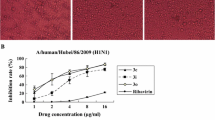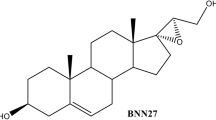Summary
Dehydroepiandrosterone (DHEA) has a significant protective effect in mice infected with West Nile virus (WNV), Sindbis virus neurovirulent (SVNI) and Semliki Forest virus (SFV). Mice injected subcutaneously (SC) with a single injection of DHEA (1 g/kg) on the same day or one day pre or post infection with WNV resulted in 40–50% mortality as compared to 100% in control injected mice (p<0.05). The drug was effective following a single SC injection or serial intraperitoneal (IP) injections (5–20mg/kg) on days 0, 2, 4, and 6 following virus inoculation. Moreover, DHEA injection not only reduced viremia and death rate, but also significantly delayed the onset of the disease and mortality. The titers of antivirus antibodies in surviving mice were very high. However, DHEA had no effect on WNV growth in BHK or Vero cell cultures. In this study it was shown that DHEA protects mice against WNV, SVNI and SFV lethal infection. Though the mechanism of the protective effect of DHEA is still unknown, it seems that DHEA can modify the host resistance mechanisms rather than the virus itself.
Similar content being viewed by others
References
Barrett-Connor E, Khaw KT, Yen SS (1986) A prospective study of dehydroepiandrosterone sulfate, mortality and cardiovascular disease. N Engl J Med 315: 1519–1524
Ben-Nathan D, Lustig S, Feuerstein G (1989) The influence of cold or isolation stress on neuroinvasiveness and virulence of an attenuated variant of West Nile virus. Arch Virol 109: 1–10
Ben-Nathan D, Feuerstein G (1990) The influence of cold or isolation stress on resistance of mice to West Nile virus encephalitis. Experientia 46: 285–290
Blalock JE (1987) Virus induced increase in plasma corticosterone. Science 238: 1424–1425
Claman HN (1984) Anti-inflamatory effects of corticoids. Clin Immunol Allergy 4: 317–329
Dulbeco R, Vogt M (1956) Plaque formation and isolation of pure lines with poliomelitis viruses. J Exp Med 99: 167–182
Gianelly AA, Terner C (1968) Inhibition of cholesterol biosynthesis by DHEA in lactating mammary gland. Endocrinology 83: 1311–1315
Goldblum N, Sterk VV, Paderski B (1954) West Nile fever: the clinical features of the disease and the isolation of West Nile virus from the blood of nine human cases. Am J Hyg 59: 89–103
Grossman CJ (1985) Interaction between the gonadal steroids and the immune system. Science 227: 257–260
Loria RM, Inge TH, Cook SS, Szakal AK, Regelson W (1988) Protection against acute lethal viral infections with the native steroid dehydroepiandrosterone (DHEA). J Med Virol 26: 301–314
Lynden DL, Huber SA (1984) Aggravation of coxsackievirus, group B, type 3 induced myocarditis increase in cellular immunity to myocyte antigens in pregnant Balb/c mice and animals treated with progesterone. Cell Immunol 87: 462–472
Lustig S, Halevy M, Ben-Nathan D, Schneider P, Kafri Y, Akov Y (1990) Biological characters of three strains of Sindbis virus, differing in virulence and invasiveness. Isr J Med Sci 26: 345
Migeon CJ, Keller AR, Lawrence B, Shepard TH (1957) Dehydroepiandrosterone and androsterone levels in human plasma effect of age, sex, day and diurnal variations. J Clin Endocrinol Metab 17: 1051–1061
Parillo JE, Fauci AS (1979) Mechanisms of glucocorticoid action on immune processes. Annu Rev Pharmacol Toxicol 19: 179–201
Rager-Zisman B, Allison AC (1973) The role of antibodies and host cells in the resistance of mice against infection by Coxsacie B 3 virus. J Gen Virol 19: 329–338
Reed LG, Muench M (1938) A simple method of estimating fifty percent endpoints. Am J Hyg 27: 493–497
Rosenfeld RS, Hellman L, Roff Wang H, Weitzman ED, Fukishima DK, Gallagher TF (1971) Dehydroisoandrosterone is secreted episodically and synchronolously with cortisol by normal man. J Clin Endocrinol Metab 33: 87–91
Riley V (1981) Psychoneuroendocrine influence on immune competence and neoplasia. Science 212: 1100–1109
Riley V (1982) Basic and applied studies on the physiology and pathology of stress: the anti-stress action of dehydroepiandrosterone. In: Murdoch MJ (ed) Foundation report. Pacific North West Research Foundation, Seattle, Washington
Sharma DC, Forchielli E, Dorfman RI (1963) Inhibition of enzymatic steroid 11β-hydroxilation by androgens. J Biol Chem 238: 572–575
Smith EM, Meyer WJ, Blalock JE (1981) Virus-induced corticosterone in hypophysecotomized mice: a possible lymphoid adrenal axis. Science 218: 1311–1312
Sonka J, Gregorova J, Krizek V (1964) Dehydroepiandrosterone in gout. Steroids 4: 843–848
Thong HY, Vincent MM, Hensen SA, Fuccillo DA, Rola-Plesczynski M, Bellanti J (1975) Depressed specific cell mediated immunity to herpes simplex virus type 1 in patients with recurrent herpes labialis. Infect Immun 12: 76–80
Wang DY, Hayward JL, Bulbrook RD, Kumaoka S, Takatani O, Abe D, Utsundmiya J (1971) Plasma DHEA and androsterone sulphate androstenedione and urinary androgen metabolites in normal British and Japanese women. Eur J Cancer 12: 951–958
Windholz M (1976) The Merck index, 9th edn. Merck, Rahway, NJ
Yamaji J, Ibeyashi H (1969) Plasma DHEA SO4 in normal and pathological conditions. J Clin Endocrinol 29: 273–278
Yirrel DL, Blyth WA, Hill TJ (1987) The influence of adrogens paralysis in mice following intravenous inoculation of herpes simplex virus. J Gen Virol 68: 2461–2424
Author information
Authors and Affiliations
Rights and permissions
About this article
Cite this article
Ben-Nathan, D., Lachmi, B., Lustig, S. et al. Protection by dehydroepiandrosterone in mice infected with viral encephalitis. Archives of Virology 120, 263–271 (1991). https://doi.org/10.1007/BF01310481
Received:
Accepted:
Issue Date:
DOI: https://doi.org/10.1007/BF01310481




